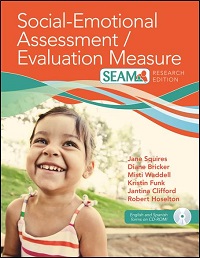Designing An Evaluation Tool To Measure Emotional Goals
SEAM
An in-depth approach to social-emotional development.
The Social-Emotional Assessment/Evaluation Measure (SEAM™) is an assessment that focuses exclusively on social-emotional and behavioral development in young children—and provides meaningful insights to caregivers and families. It provides in-depth information that can prevent problems by building positive partnerships with families and optimizing positive parent–child interactions in the first years of life.
See how.
Overview
An effective and comprehensive approach to social-emotional assessment.
With this in-depth, easy-to-use tool, social-emotional competence and development can be reliably assessed and monitored in infants, toddlers, and preschoolers at risk for delays or challenges. An ideal follow-up to screeners such as ASQ ® :SE-2, the two-part SEAM™ assessment reveals detailed qualitative information on children's social-emotional competence— and identifies their caregivers' strengths and areas of need. Easy to learn and implement, SEAM can be used by a wide variety of early childhood professionals, including those with little or no training in mental health or behavioral interventions.
SEAM helps professionals to:
- support development of important social-emotional skills in order to minimize challenging behaviors
- build strong, proactive partnerships with families
- promote positive parent–child interactions in the critical first years of life
- assist with choosing developmentally appropriate goals and intervention activities
- monitor child progress toward social-emotional goals
SEAM is a two-part assessment available in English and Spanish; see how it works.
View the Using the SEAM with Young Children webcast, presented by SEAM developers Jane Squires, Ph.D., and Misti Waddell, M.S.
Watch the SEAM webcast
Product Details
SEAM, Research Edition
User's Guide, plus CD-ROM with master forms in English and Spanish
$52.00 • Stock Number: 72803 • 2014 • ISBN 978-1-59857-280-3

How It Works
SEAM: How it works.
SEAM is a two-part assessment: SEAM child assessment and SEAM Family Profile.
SEAM Child Assessment
This assessment includes three intervals with different developmental ranges:
- Infant(2–18 months)
- Toddler(18–36 months)
- Preschool(36–66 months)
Each interval assesses 10 child benchmarks critical to social-emotional competence, including empathy, adaptive skills, self-image, emotional responses, and healthy interactions with others.
SEAM is flexible enough to meet your specific needs—parents/caregivers can complete it independently, or it can be conducted jointly with healthcare providers if desired. The SEAM system also includes SEAM with Ages, an alternate version of the tool annotated with a helpful list of age ranges for each item. This version makes it easy to give caregivers general guidance on how social-emotional skills typically develop and where their child's development fits on the continuum.
See a sample SEAM Form
SEAM Family Profile
The Family Profile assesses parent and caregiver strengths and helps identify areas in which they need more supports and resources to foster their child's social-emotional skills. Like the main SEAM, the Family Profile assessment includes three intervals—Infant, Toddler, and Preschool. Each interval measures four benchmarks key to a nurturing home environment: responding to needs, providing activities and play, providing predictable routines and an appropriate environment, and ensuring home safety.
See a sample Family Profile form
View the developers' SEAM poster from the 2014 Zero to Three National Training Institute
See the SEAM Poster
View a presentation on SEAM and ASQ:SE from the 2014 NAEYC conference
See the Presentation
At a Glance
What does it assess?
The Social-Emotional Assessment/Evaluation Measure (SEAM) is an assessment tool for measuring children's social-emotional development and parenting competence.
Who are the developers?
SEAM was developed by some of the key developers and trainers for the Ages & Stages Questionnaires: Social-Emotional, Second Edition (ASQ:SE-2) screener: Jane Squires, Ph.D., Diane Bricker, Ph.D., Misti Waddell, M.S., Kristin Funk, M.A., LCSW, Jantina Clifford, Ph.D., and Robert Hoselton.
What is the age range of children assessed?
What are the components?
The SEAM Tool – includes three intervals with different developmental ranges: Infant (2–18 months), Toddler (18–36 months), and Preschool (36–66 months) and helps identify a child's strengths, concerns for the family that need monitoring, and agreed-on focus areas
The SEAM Family Profile – also has three developmental intervals and assesses parent and caregiver strengths and helps identify areas in which they need more supports and resources to foster their child's social-emotional skills
(The SEAM system also includes SEAM with Ages, an alternate version of the tool annotated with a helpful list of age ranges for each item.)
What does it examine?
For each interval, the Tool assesses 10 child benchmarks critical to social-emotional competence:
- Child participates in healthy interactions
- Child expresses a range of emotions
- Child regulates social-emotional responses
- Child begins to show empathy for others
- Child attends to and engages with others
- Child explores hands and feet and surroundings (for infants)/demonstrates independence (for toddlers/preschoolers)
- Child displays a positive self-image
- Child regulates activity level
- Child cooperates with daily routines and requests
- Child shows a range of adaptive skills
The Family Profile also measures four benchmarks key to a nurturing home environment for each interval:
- responding to needs
- providing activities and play
- providing predictable routines and an appropriate environment, and
- ensuring home safety
Where is it conducted?
In early childhood programs, homes, or other settings where children are served
Who conducts it?
Early interventionists, early childhood teachers, Head Start & Early Head Start staff, home visitors, parent educators, and mental health professionals
How long does it take to complete?
15–30 minutes (SEAM/SEAM with Ages)
10–15 minutes (Family Profile)
What languages is it available in?
English and Spanish (both are included on the CD-ROM)
Is it research-based?
Yes, SEAM has been researched with 2,200 children from 49 U.S. states and Canada.
How can the results be used?
Qualitative data from the SEAM and Family Profile can be used to determine areas for greater intervention; answers can be converted to numerical values for progress monitoring.
Hear from the SEAM developers why it's important to measure social-emotional development.
Read the Interview
Technical Info
Research and validity specifics for SEAM
To confirm the utility and efficacy of SEAM, intensive research has been performed—details can be viewed below.
| Research sample | 2,200 children from 49 U.S. states and Canada |
| Inter-rater reliability (SEAM and SEAM with Ages) | Infant: 0.776 p < .01 Toddler: 0.752 Preschool: No data |
| Test-retest reliability (SEAM and SEAM with Ages) | Infant: 0.987 p < .01 Toddler: 0.968 p < .01 Preschool: 0.989 p < .01 |
| Concurrent Validity (SEAM and SEAM with Ages) | Infant: .754** with DECA-IT .628** with ITSEA Compliance, -.415* with ITSEA Negative Emotion, .651** with ITSEA ProSocial -.557** with ASQ:SEToddler: .564** with ITSEA Compliance, -.261** with ITSEA Negative Emotion, .652** with ITSEA ProSocial -.516** with ASQ:SEPreschool: -.810** with ASQ:SE* p < .05 ** p < .01 |
| Utility (SEAM and SEAM with Ages) | Parents (sample of 434)
Practitioners (sample of 35)
|
For more technical details, view SEAM's technical report.
Read more
-

"We chose ASQ because it is easy to do, low cost, culturally sensitive, and it meets our purpose of basic screening for our children's development. Our infant teachers base their curriculum on each individual child based on the ASQ."
Kathy Bostic, Program Supervisor, Pinehurst Child Care Center
Designing An Evaluation Tool To Measure Emotional Goals
Source: https://agesandstages.com/products-pricing/seam/
Posted by: rickshembill.blogspot.com


0 Response to "Designing An Evaluation Tool To Measure Emotional Goals"
Post a Comment